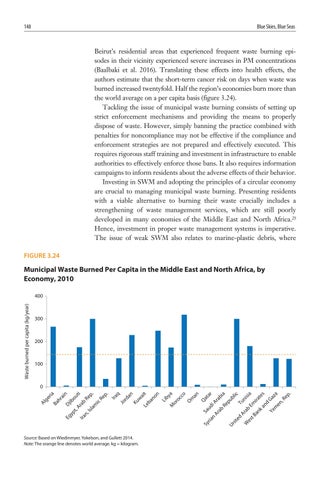148
Blue Skies, Blue Seas
Beirut’s residential areas that experienced frequent waste burning episodes in their vicinity experienced severe increases in PM concentrations (Baalbaki et al. 2016). Translating these effects into health effects, the authors estimate that the short-term cancer risk on days when waste was burned increased twentyfold. Half the region’s economies burn more than the world average on a per capita basis (figure 3.24). Tackling the issue of municipal waste burning consists of setting up strict enforcement mechanisms and providing the means to properly dispose of waste. However, simply banning the practice combined with penalties for noncompliance may not be effective if the compliance and enforcement strategies are not prepared and effectively executed. This requires rigorous staff training and investment in infrastructure to enable authorities to effectively enforce those bans. It also requires information campaigns to inform residents about the adverse effects of their behavior. Investing in SWM and adopting the principles of a circular economy are crucial to managing municipal waste burning. Presenting residents with a viable alternative to burning their waste crucially includes a strengthening of waste management services, which are still poorly developed in many economies of the Middle East and North Africa.29 Hence, investment in proper waste management systems is imperative. The issue of weak SWM also relates to marine-plastic debris, where FIGURE 3.24
Municipal Waste Burned Per Capita in the Middle East and North Africa, by Economy, 2010
Waste burned per capita (kg/year)
400
300
200
100
Source: Based on Wiedinmyer, Yokelson, and Gullett 2014. Note: The orange line denotes world average. kg = kilogram.
ra b Re ia pu Un bl ic ite d T u Ar n W ab isi es a t B Em ira an te ka nd s Ye Ga z m en a ,R ep . ab
Ar n
Sy
ria
an
ta r
iA
Sa
ud
Qa
co
Om
ya
oc or
Lib
M
w ai t Le ba no n
an
Ku
q
rd Jo
am Isl
Ira
.
ic
b ra
n,
Ira
pt ,A Eg y
Re p
ti Re p.
n
ou
ai
ib Dj
hr
Ba
Al
ge r
ia
0






